
 | |
| Volume 8, Number 4 | July/August 2002 |
Otzi's body was found in 1991 in the high mountains of the Alps where he lived. Unusual weather conditions produced an unusually large melt of the Alpine glaciers that summer. Hikers happened upon the body, only partially freed from its icy tomb. Supposing they had found remains of an unfortunate modern climber, local authorities were notified.
Many modern climbers have accidents. The bodies are sometimes lost in the glaciers for decades. The team which came to remove the Iceman's body assumed this was simply another such case.
They soon changed their minds. Modern climbers do not carry flint knives and copper axes. In fact, that sort of gear has not been used in the Alps for at least 4000 years. It was soon apparent that the body was that of a man who had lived and died thousands of years previously.
He was soon nicknamed "Otzi" after the Ötztal Alps where he was found. Otzi is the world's oldest frozen mummy.
Otzi comes to us from thousands of years ago, almost as one frozen in time. Much of our knowledge of peoples of such ancient times has been surmised from their archaeologically excavated graves. But Otzi was not buried. He died on the mountain in the midst of his everyday activities. He was naturally mummified in ice, and hence preserved, with all of his gear around him. Thus Otzi allows an amazingly clear look into daily life in the Alps over four thousand years ago.
The discovery of Otzi created an immediate sensation around the world. It fascinated the general public, and turned out to be an archaeological gold mine.
 |
I am not an expert on Otzi, by any means. In fact, I am not even especially well-researched on him. At present I continue to be absorbed, as I have been for several years now, by the problem of why human longevity declined following Noah's Flood.[1] At the moment several key experiments are underway in the longevity research laboratory, on which I am waiting for results. I think I am very near the end of this long quest; the experiments presently in progress will show just how near the end I may be. While I wait, a bit of a diversion would be welcome. Otzi nicely fills the bill.
While I am not an expert on Otzi, I am an expert on Biblical chronology. As an expert on Biblical chronology I have noticed for some time now that Otzi is able to make a contribution to our knowledge in this field, and vice versa. In fact, Otzi and ancient Bible history complement each other rather nicely, each shedding additional light on the other.
I have also noticed that nobody else seems to have noticed this affinity. I have seen reference to Otzi's antiquity relative to the pyramids of Egypt—which he predates—but never any reference to Otzi's antiquity relative to Moses, or Abraham, or Noah, for example. I hope, in the present article, at least to remedy this oversight.
I will not spend much time describing Otzi or his gear. You can learn plenty about these things through a simple search of the Internet. He wore carefully stitched leather clothes, a grass cape, and leather boots stuffed with dry grass for insulation (Figure 1). Besides the flint knife and copper axe, he carried a long bow, a quiver full of arrows, a backpack, and a utility belt with an assortment of tools. He was intimately associated with the smelting of copper ores. He appears to have died of an arrow wound in the back.
My goal in the present article is to bring Otzi and Biblical history together. This is clearly a reachable goal, because the history of the ancient past recorded in the Bible is a history of the very same planet—Earth—on which Otzi walked. And, as Biblical history reaches back over seven thousand years, it is certain to include the time when Otzi lived.
Biblical history opens in Genesis with the supernatural creation of Earth, and the universe of which it is a part, 5176±26 B.C.[2] The early chapters of Genesis inform us of the creation of Adam and Eve and their Fall into sin.
A mere 1500 years later the earth was filled with people—and with violence. God singled out Noah to build a very large barge, by which means he and his family escaped God's judgment of mankind, sent in the form of a Flood.
The Flood happened 3520±21 B.C.[3] Much extra-Biblical data shows that the physical cause of the Flood was a cosmic projectile impact in the high northern latitudes.[4] Iceland seems the most probable site of the impact center at present.
The energetic impact of the cosmic projectile resulted in displacement of the inner core of the earth relative to the mantle and crust.[5] This produced a geoid warp (i.e., a gravitational anomaly) which caused the water of the southern oceans to flow into the northern hemisphere, resulting in ocean-deep flooding of the northern hemisphere. Only a few tall mountains would have poked above the surface of the Flood in much of the northern hemisphere, while southern land masses were left high and dry. This state persisted 150 days, until the velocity of currents generated within the molten outer core by the displaced inner core had decayed sufficiently for the inner core to begin to return to its normal, centered position.
The Flood terminated civilization throughout the northern hemisphere. The Flood is, for example, the cause of the extermination of the Neolithic civilization whose remarkably preserved agricultural fields and stone walls are found today beneath the peat at Céide Fields, Ireland,[6] and the cause of the extinction of Chalcolithic culture seen in archaeological remains throughout the land of Israel.[7]
Following the Flood, civilization in the northern hemisphere had to begin again from scratch. Noah's descendants stayed together initially. They followed the Tigris-Euphrates river system from the mountains of Turkey, where Noah's barge had come to rest, down-river toward the Persian Gulf. In the flat, fertile, desert plain between the rivers they determined to build a city and a tower. But God confused their languages so they could no longer understand one another. The result was the Dispersion of Noah's descendants from Babel into the far-flung regions of Europe, Asia, and northern Africa.
While civilization began afresh after the Flood, something had clearly gone wrong with Earth's environment as a result of the Flood. Prior to the Flood people had lived nearly a thousand years. Now life spans were declining rapidly. By 3300 B.C., little more than two hundred years following the Flood, average life expectancy had plummeted from 925 years to just 200 years.
Where does Otzi fit into all of this?
To answer this question it is only necessary to determine the proper absolute date of Otzi's death. Fortunately, radiocarbon dating provides a simple means of determining this date.
Many samples, both directly from Otzi's tissues and from items associated with Otzi (e.g., wood from his axe handle, grasses from his cloak, etc.), have now been radiocarbon dated.[8] I have plotted seventeen radiocarbon results reported by Rom et al. in Figure 2.
 |
As usual, radiocarbon does not yield a single date for a sample. Rather, it yields date ranges with associated relative probabilities. The most probable date range from Otzi's tissues alone is 3360–3310 B.C. The date ranges from associated samples, shown in Figure 2, strongly support this range. Thus the best estimate at present of the date of Otzi's death appears to be 3335±25 (2σ) B.C. This date is shown in Figure 2 by the horizontal dashed line drawn through the radiocarbon date ranges.
The first thing to notice about this date is that it falls after the Flood, not before it.
This is as it must be, of course. It is not possible that Otzi and all his gear could have survived in place in the Alps through the Flood—with ocean water flowing in, covering everything for 150 days, melting the glaciers as it did at Devon Island,[9] then flowing back out again. Otzi must date after the Flood, as radiocarbon clearly shows he does.
Determining the date of Otzi's birth is a much more difficult problem.
According to the reports I have read, the anthropologists who examined Otzi have placed his age at death around 45 years. If this estimate were dependable it would be an easy matter to calculate the date of Otzi's birth. It would then be simply (3335 + 45 =) 3380 B.C.
Unfortunately for the present purpose the anthropologists' estimate is almost certainly not correct. The difficulty is that they have failed entirely to reckon with the fact that people were living much longer back at that time than they do today. Otzi may look about the way a 45 year old man might look today, but that does not yield the automatic conclusion that Otzi was about 45 years old, as they have supposed, by any means.
How do people look who live for hundreds of years? This is not an easy question to answer because we have absolutely no data on it from living people today.
One could imagine that multi-centenarians from the ancient past aged in much the same way people age today. That is, they were quite visibly aged by 100, and they just stayed that way from then on.
But the Bible suggests otherwise. Isaiah, for example, prophesying about the restoration of longevity, says, "the youth will die at the age of 100…" [my emphasis].[10]
The Biblical vision of 100 year old youths opens the door to all sorts of possibilities, including even the possibility that people who lived multiple centuries in the ancient past retained a youthful appearance and vigor most of their lives, and only began to show the characteristic features of 'old age' in the final few decades of their lives.
This uncertainty obviously prohibits us from knowing for sure how old Otzi was when he died, but the anthropologists' estimate is almost certainly much too young. Notice that if we assume people aged in strict proportion to the rate of aging today (I am not recommending this as the correct choice) and if we interpret the anthropologists' 45 years to mean that Otzi appears to have been a little past middle age when he died, then he must have passed his one hundredth birthday. This follows from the Biblical life span data which show the life expectancy of a newborn at the time of Otzi's death to be still in excess of 200 years (Figure 3). Otzi may look the way 45 year-olds look today, but his true age at death was probably in excess of twice that figure.
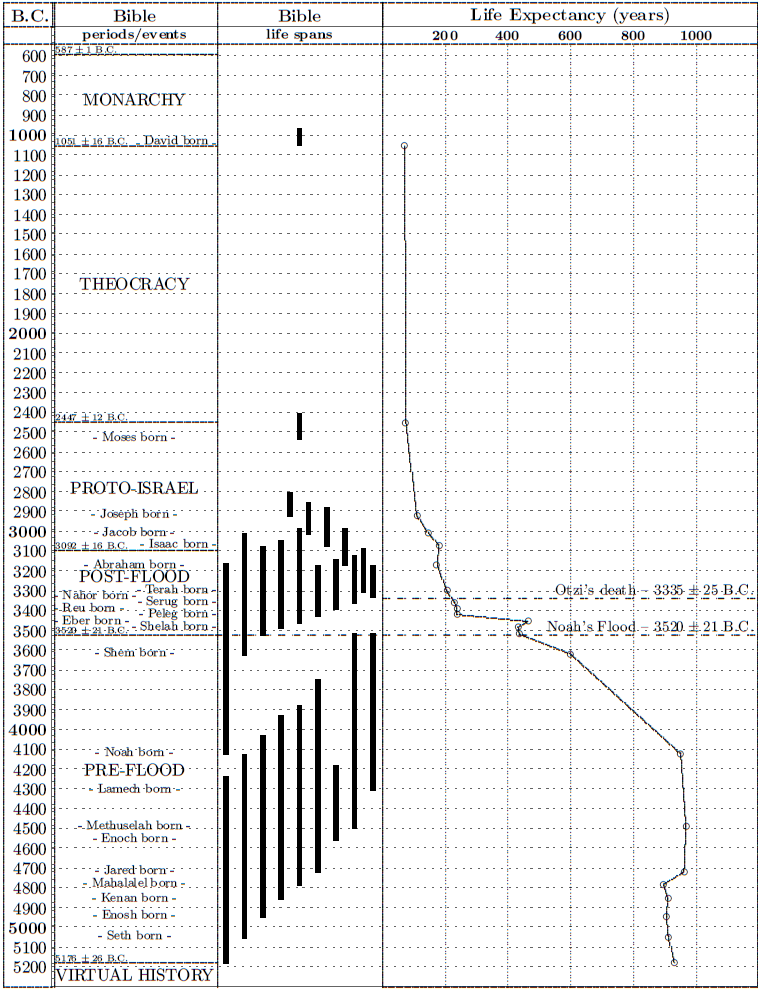 |
Otzi lived and died only a few centuries after the Flood. Yet the equipment he carried with him was well adapted to life in the Alps. This implies that the Alps were his home, and that he had lived there for some time.
From the known depth and duration of the Flood in the region of the Alps,[11] it seems that all pre-Flood Alpine populations must have been entirely exterminated by the Flood. This implies that the Alps must have been repopulated from an outside source following the Flood—that Otzi's ancestors had not lived in the Alps.
By far the most reasonable choice is that Otzi was a descendant of Noah, and I will assume this to be the case in what follows. But please note that we do not know this with certainty. The Biblical historical record acknowledges the continuity of other than just Noah's genetic line through the Flood. This is explicitly seen in the existence of the genetic line of the Nephilim both before (Genesis 6:4) and after (Numbers 13:33) the Flood.
In addition to this Biblical evidence, the hemispherical Flood model also anticipates continuity of other genetic lines through the Flood. It allows the possibility of survival of some people in northern latitudes on very tall mountains, the peaks of which were not inundated according to this model. And it strongly implies continuity of non-Noahic genetic lines in southern latitudes, which were not flooded at all.
Nonetheless, the hemispherical Flood model leads to an expectation of survival of very few pre-Flood genetic lines in northern latitudes, both because of the rarity of sufficiently tall mountains, and because of the great difficulty the Flood would have presented to survival on such mountains.
Genesis 10 documents the origin from Noah's descendants of "the nations" surrounding the Mediterranean. Genesis 10:33 seems especially to imply that these nations were entirely and exclusively due to descendants of Noah. This implies a general absence of other genetic lines in the region surrounding the Mediterranean following the Flood.
These considerations lead to the conclusion that Otzi was almost certainly a descendant of Noah.
This conclusion has immediate implications for the Date of the Dispersion from Babel.
I have previously computed the date of the Dispersion as follows:[12]
In Genesis 10:25 we learn that the Dispersion happened in the days of Peleg (which name means division). From Genesis 11:10–16 we learn that Peleg was born about 100 years after the Flood, and from Genesis 11:18–19 we learn that Peleg died when he was 239 years old. Thus, the Dispersion must have occurred no sooner than about 100 years, and no later than about 340 years after the Flood.Otzi allows us to narrow this range.
Otzi died roughly 185 years after the Flood. If we estimate that he must have lived in the Alps for at least a decade, as his specialized equipment implies, then he could have arrived in the area not much later than 175 years after the Flood. This suggests that the Dispersion from Babel must have taken place between 100 and (allowing for the ±25 year uncertainty in Otzi's date of death) 200 years after the Flood.
This eliminates most of the 240 year range for the date of the Dispersion given in the above quote, leaving only the first 75 years of it. The result is to refine the date of the Dispersion from 3300±120 B.C. to 3370±50 B.C.
Noah himself was still alive when Otzi died (Figure 3), so Otzi was a contemporary as well as a descendant of Noah. It is quite possible that Otzi had personally met Noah. This possibility is suggested by simple population growth estimates.
55 live births per 1000 total population per year is considered to be a large birth rate for human populations.
The figure for the United States in 1800, when the population was undergoing as rapid an expansion as any known, has been calculated at 55 per 1,000.[13]Assume that this figure applies to the post-Flood population in the centuries immediately following the Flood. Use of this large birth rate seems appropriate because the population in those early centuries would not have included any elderly people. For the same reason we do not need to worry about the effect of death due to 'old age' on the total population in those centuries.
If we assume that Otzi was 100 years old at the time of his death, then the population at the time of his birth would have been only about 750 individuals. It is not difficult for everybody to know everybody in an intimately associated group (e.g., a clan) of this size. Thus it seems possible that Otzi knew Noah personally.
Carrying on with these same assumptions, Otzi would have been at least fifteen years old at the time of the Dispersion. This implies that he was an eye witness and participant in that historic event. By that time the total population would have reached about 1,700 individuals—the right order of magnitude for the decision to build a city and a tower to keep everybody together.
By the time of Otzi's death, Noah's descendants would have numbered in excess of 160,000. (Another 100 years later they would have numbered in excess of thirty million.)
All of this is rather rough, of course. High precision is not easy to achieve when peering back over five thousand years. But these rough estimates give us a reasonable idea, in first approximation, of the world in which Otzi grew up, filling, I hope, some of the vacuum left by the secular scientists and popular press in this regard.
In closing, let me attempt a brief imaginative yet historically/archaeologically based reconstruction of Otzi's life and times.
Otzi was born to Noah's clan as they migrated out of the Ararat region, following the river year by year, toward the southeast. They moved with some knowledge of where they were going—back toward 'the good land' of Noah's birth.
A century previously the rivers of this region had been busy with commerce, irrigated fields had lined their banks, and urban centers were a common sight. But now the clan moved when and where they pleased, unhindered and unchallenged. There was no one to stop them—the region had been completely depopulated by a great Flood some decades previously.
Otzi had reached his early teens when the clan came to a broad and lovely plain. They determined to make this spot their permanent home. Here they would settle down and begin to enjoy the good life. They would irrigate the fields once again, and reroot the urban way of life which the Flood had extinguished. They would establish for themselves a unified ethnicity and a high civilization in the land of their ancestors, of the sort the ancients had known.
But their plans were ruined before the city and tower had progressed very far. The clan came down with a previously unheard of cognitive disturbance which altered verbal communication. It only affected a few individuals at first, but within a few days nearly all were afflicted with it. In the virtual communication blackout which followed imaginations ran wild, unfounded fears mounted to panic, and people fled.
Otzi stuck with his family: his mother and father and brothers and sisters. They worked their way back up river, with their livestock and other possessions, in the direction they had originally come.
They traveled on for years. Most members of the group had been born into a migrant way of life. The land was wide open before them, food was abundant, and they saw no reason to settle down.
They came eventually to a region of soaring mountains. Here was a new sort of 'good land', with a great variety of natural plant and animal resources in close proximity to protected valleys, occasioned by the rapidly changing altitudes of the mountain slopes. Copper ore, too, protruded from the mountainsides in places. And the high altitude snow fields guaranteed there would never be a shortage of fresh water, even in the hottest, driest summers.
They moved into one such valley. Their descendants still inhabit it today. ◇
 |
In Part I of this series I invited you to look with me at an ancient ruined city, and at the young woman whose intense interest in Bible history caused those ruins—after thousands of forgotten, silent years—to reveal a story. Most of the story of this ancient city had perished and been forgotten, together with the many families who called Ai home. Only the end of the story had not been forgotten. It had been preserved and is still available to us in the book of Joshua, in the Bible.
Many have studied the story told by the archaeological ruins at Ai, and many more have read and studied the story of how those ruins came about in the Bible. These two stories should be integrated, of course. They should be woven together into what they in fact are: one reality that happened when an army of God-believing nomads attacked a population of idol-worshipers in their massively-walled city.
The city of Ai sat proudly on its hilltop long before the Israelite army ever existed. Around 3100 B.C., about 400 years after the disaster we know as Noah's Flood, a group of people, possibly from area towns, decided to build a village on the hill. Maybe the other towns were getting too crowded. We don't know. Soon the village at Ai grew as more settlers moved into the region, apparently from north of Canaan. The settlement covered an area of about 10 acres, a size rivaling that of prosperous towns built in the same region 2000 years later.
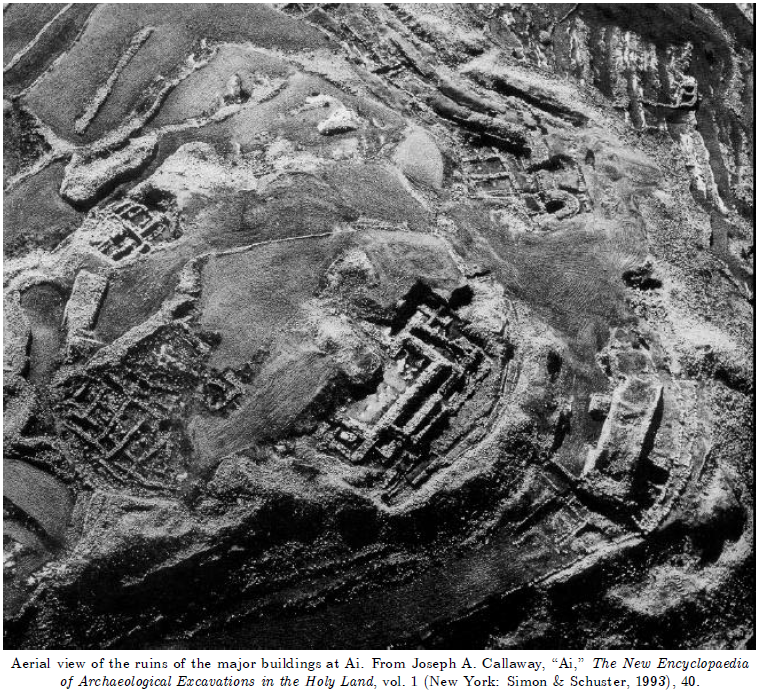 |
Typical houses in the Early Bronze Age (the time period during which Ai was a city) had one main room, and sometimes a small adjoining storage room. The main room was usually rectangular with a single door set in one of the long walls. This characteristic gives this type of house the name broadhouse. Each family unit apparently designed and built their own house, so there are many variations on the basic broadhouse design.
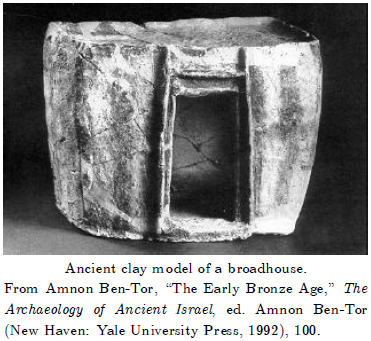 |
The floors of the houses tended to be below street level, so a few steps led down from the street. The door turned on a stone socket and opened inward and to the left. Furniture included stone benches along the walls, and stone slabs set on the floor. The roof was supported by wooden poles. They appear not to have had many windows, perhaps to keep the hot sun and wind-blown sand out.
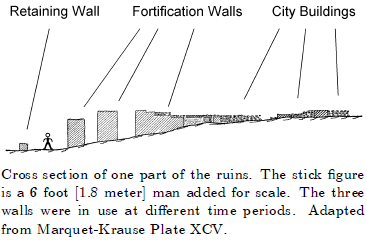 |
Another type of house which was common during this time is known as the "front-room" house. These houses had an open courtyard in front where a hearth or silo was often located.
Some of the pottery made by the settlers of Ai had shapes and decorations that hadn't been used in that area before. Archaeologists assume that they either invented these new styles, or learned them from foreigners who joined them in settling Ai.
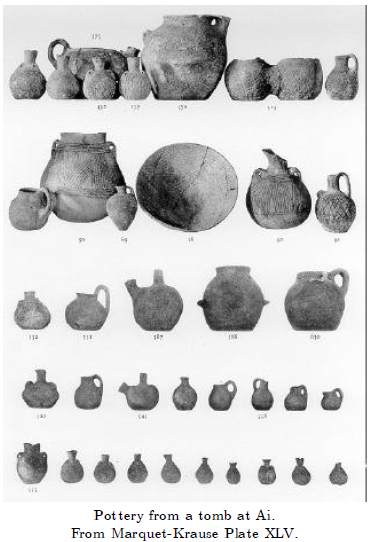 |
About 100 years after Ai was founded, a new town layout was planned and built, complete with massive city walls for protection. These walls were over 15 feet (4 meters) high in some places. They were built of field stones. They probably had mud-brick walls built on top of them, making them even higher.
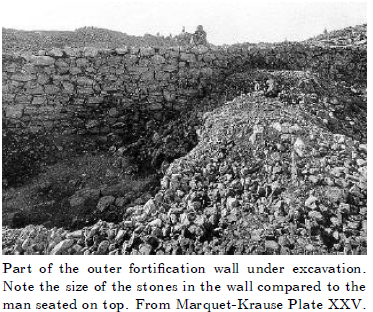 |
Generations of people lived and died at Ai, and there was no major destruction or reconstruction for the next 280 years (longer than the United States of America has been a nation). Then the city was destroyed, apparently by an earthquake which leveled buildings and caused an intense fire. The fire was hot enough in places to reduce stones to powder.
However, the people of Ai soon rebuilt their city and the fortification walls. They also seem to have moved their cult objects from the temple/palace building near the top of the hill into a building next to a part of the wall that was much thicker than the rest. This new temple is one of the greatest points of interest in the ruins of Ai. Here the people of Ai burned incense and offered sacrifices. Remains of sacrifices—poultry and cattle—were found in the temple, along with knife handles and pottery used in the cult.
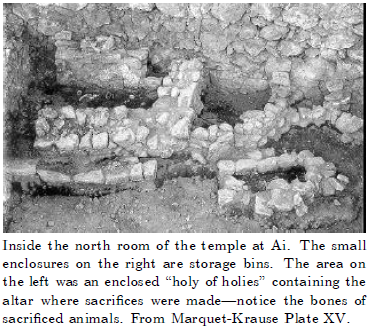 |
We know the people of Ai were religious, although we don't know a lot about the cult they practiced. Some finds suggest that the "Dumuzi" cult was involved.[14] Dumuzi was the god of vegetation, according to Mesopotamian texts. When the hot summer came and the vegetation died, the death of Dumuzi was mourned.
No doubt the religion of Ai involved other and varied elements.
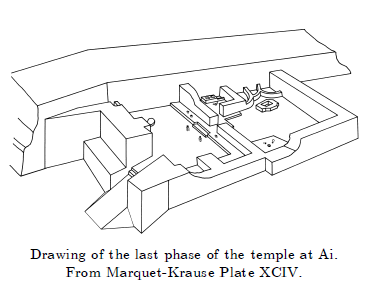 |
To be continued. ◇
The Biblical Chronologist is a bimonthly subscription newsletter about Biblical chronology. It is written and edited by Gerald E. Aardsma, a Ph.D. scientist (nuclear physics) with special background in radioisotopic dating methods such as radiocarbon. The Biblical Chronologist has a threefold purpose: to encourage, enrich, and strengthen the faith of conservative Christians through instruction in Biblical chronology, to foster informed, up-to-date, scholarly research in this vital field within the conservative Christian community, and to communicate current developments and discoveries in Biblical chronology in an easily understood manner. An introductory packet containing three sample issues and a subscription order form is available for $9.95 US regardless of destination address. Send check or money order in US funds and request the "Intro Pack." The Biblical Chronologist (ISSN 1081-762X) is published six times a year by Aardsma Research & Publishing, 412 Mulberry St., Loda, IL 60948-9651. Copyright © 2002 by Aardsma Research & Publishing. Duplication or distribution in whole or in part by any means electronic or otherwise is strictly prohibited without written permission from the publisher.
|
^ Gerald E. Aardsma, "The Cause of Reduced Post-Flood Life Spans – Part I," The Biblical Chronologist 7.2 (March/April 2001): 1–6; Gerald E. Aardsma, "The Cause of Reduced Post-Flood Life Spans – Part II," The Biblical Chronologist 7.4 (July/August 2001): 1–7; Gerald E. Aardsma, "The Cause of Reduced Post-Flood Life Spans – Part III," The Biblical Chronologist 7.5 (September/October 2001): 1–5; Gerald E. Aardsma, "The Cause of Reduced Post-Flood Life Spans – Part IV," The Biblical Chronologist 8.1 (January/February 2002): 1–8; Gerald E. Aardsma, "The Cause of Reduced Post-Flood Life Spans – Part V," The Biblical Chronologist 8.3 (May/June 2002): 1–4.
^ Gerald E. Aardsma, "Toward Unification of Pre-Flood Chronology," The Biblical Chronologist 4.4 (July/August 1998): 1–10.
^ Gerald E. Aardsma, "Chronology of the Bible: 5000–3000 B.C.," The Biblical Chronologist 2.4 (July/August 1996): 1–5; Gerald E. Aardsma, "Radiocarbon Dating Noah's Flood – Part II," The Biblical Chronologist 6.2 (March/April 2000): 1–11.
^ Gerald E. Aardsma, "The Cause of Noah's Flood," The Biblical Chronologist 3.5 (September/October 1997): 1–14; Gerald E. Aardsma, "Zoogeography and Noah's Flood," The Biblical Chronologist 4.1 (January/February 1998): 1–7; Gerald E. Aardsma, "The Opening Minutes of Noah's Flood at Céide Fields, Ireland," The Biblical Chronologist 5.6 (November/December 1999): 1–10.
^ See Gerald E. Aardsma, "Biblical Chronology 101," The Biblical Chronologist 4.3 (May/June 1998): 6–10 for an illustrated summary of the hemispherical Flood model.
^ Gerald E. Aardsma, "Noah's Flood: The Irish Evidence," The Biblical Chronologist 5.3 (May/June 1999): 1–7.
^ Gerald E. Aardsma, "Radiocarbon Dating Noah's Flood," The Biblical Chronologist 3.6 (November/December 1997): 1–11.
^ See Werner Rom et al., "AMS 14C Dating of Equipment from the Iceman and of Spruce Logs from the Prehistoric Salt Mines of Hallstatt," Radiocarbon 41.2 (1999): 183–197 and references therein.
^ Gerald E. Aardsma, "Noah's Flood at Devon Island," The Biblical Chronologist 3.4 (July/August 1997): 1–16.
^ Isaiah 65:20.
^ Gerald E. Aardsma, "The Cause of Noah's Flood," The Biblical Chronologist 3.5 (September/October 1997): 1–14.
^ Gerald E. Aardsma, "Research in Progress," The Biblical Chronologist 1.4 (July/August 1995): 8.
^ Marston Bates, "Population," The Encyclopedia Americana, vol. 22 (Chicago: Rand McNally, 1962) 368–369.
^ Amnon Ben-Tor, "The Early Bronze Age," The Archaeology of Ancient Israel, ed. Amnon Ben-Tor (New Haven: Yale University Press, 1992), 117–118.